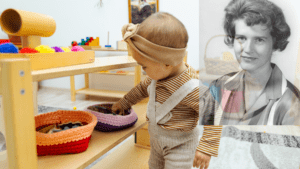The system in which a child is constantly moving objects with his hands and actively exercising his senses also considers a child’s unique aptitude for mathematics. When they leave the material, the children easily reach the point of writing out the operation. They thus carry out an abstract mental operation and acquire a kind of natural and spontaneous inclination for mental calculations. (The Discovery of the Child, Maria Montessori, pg 279)
In our work, therefore, we have given a name to this part of the mind which is built up by exactitude; we call it the ‘mathematical mind.’ – Dr. Maria Montessori, The Absorbent Mind, p. 185
This article is in continuation of “The secret of Mathermatical Minds in Montessori Education“, where we talked about basics of Mathematical minds and why Dr. Maria Montessori believed that “every child has a mathematical kind. In this article, we will talk about How Montessori curriculum is aligned to promote exploration and critical thinking.
Much of the Montessori curriculum is based on giving children exposure to concrete materials first, giving them incremental opportunities to work to more abstract concepts. There is no difference when it comes to math.
What do we mean by concrete? The children can hold material in their hands. The materials are symbolic or representative of something else (a number, perhaps). That symbolism changes over time until children are ready to let go of the materials and find solutions on paper or even in their heads. This idea of mastering a skill without the assistance of materials is what we refer to as abstraction.
Until a certain point in development, usually around age four, the child enters the sensitive period for numbers, and the child’s mathematical nature awakens. She graduates from purely sensorial explorations to an interest in specific measuring and counting. Once begun, the child progresses through the math materials sequentially.
Math exercises according to groups in Montessori
Stage 1 –
The first group of exercises is work with numbers 1 to 10. The child learns the quantities from 1 to 10 through a very concrete experience with the number rods. After this, we introduce symbols and the child learns to associate quantity and symbol with the number rods and cards. The sandpaper numbers isolate the symbols for the quantities, and tracing them prepares the hand for writing numerals. We introduce zero as a concept with the spindle boxes, and the child learns to isolate symbols and quantities – zero through 9.
With Cards and Counters, the child lays out the cards and the counters in a particular way. This work is also an introduction to odd and even numbers. With the Memory game, the child relates what she knows about numbers 0-10 to the environment.
These exercises give the child experience that allows variety and repetition. The presentation of the Golden Bead bars gives a visual and a very concrete understanding of the decimal system. We begin with units, then tens, hundreds, and thousands. It all begins with quantity and then the child is given the symbols.
Later, the child is putting quantity and symbol together using bank exchange game. Following are the four operations; addition, subtraction, multiplication, and division. The child learns the terminology of individual numbers and counts and recognizes numbers from one to 1000 and beyond.
Memory work contains exercises designed to give the child an understanding and the acts necessary to work with the material in abstract terms. The child is given lessons to support her work with addition, subtraction, multiplication, and division in totally abstract terms.
During the sensitive period for numbers, the hands-on Montessori materials allow the child to form concrete impressions of the world of mathematics. It allows her to experience mathematics with positive associations and satisfaction of learning through self-discovery.
Stage 2 –
Somewhere between 4.5 years and 5 years, children are taught to use new math materials depending upon their readiness. The stamp game is a classic example. The stamp game material is a sectioned box with small colored tiles sorted inside. There are labeled green, ‘units’ tiles, blue ‘tens’ tiles, red ‘hundreds’ tiles, and green ‘thousands’ tiles.
Instead of holding a large cube that shows the relative size of one thousand as they did with the golden beads, they represent a series of tiles that are all the same size but are differentiated only by their color and number label. Like the golden beads, the stamp game material is used to teach all four operations, with children adding, subtracting, multiplying, and dividing into the thousands. Some children begin this work in their primary classroom and continue when they reach upper grades.
It may be interesting to note that there are some Montessori materials that children spiral back to, over and over again, from ages 3 to 12! The bead chains are a colorful, quintessential Montessori material. In the primary classroom, children use the material to learn how to count and skip count. In the nursery classroom, they are used for skip counting and to help memorize multiplication facts. Children then use them to solidify concepts like squaring and cubing, although they were indirectly preparing for that work for years previously.
Stage 3 –
Up to 5 years, many children continue to use the strip boards and bead boards of their primary years but eventually move on to using fingerboards and tables to place numbered tiles. Children notice the patterns numbers make, giving them more tools to memorize their facts.
Of course, math isn’t just about operations. Montessori students learn about geometry and fractions from an early age.
When it comes to fractions, first graders start simple with an impressionist lesson involving an apple and a definition of fractions that includes how they must always be fairly divided (the connections between fractions and division are impressed early on). Then next move on to using fraction insets, which look a lot like the metal insets they used for handwriting preparation in their primary classrooms. Before you know it, many second graders are learning to multiply and divide fractions.
Progression of Learning from Simple to Complex in Montessori Education
In a nutshell, the Montessori classroom offers a slow and gradual progression of learning from simple to complex. There is learning at different stages of activity. For example, first, we start with addition, and then begin by adding numbers on small rods, then recording it, and then moving to the additional board with summary cards.
This progression serves two purposes:
- The mind understands the concept in abstract and concrete.
- The mind is now prepared for any number of questions because the process to solve repeated multiple times.
Even for addition or subtraction exercises, the Montessori material is prepped in such a way that the child first performs the activity with one numeral and all its variations like in subtraction. When we use the subtraction board, we first use scales to make the number clear and then subtract different quantities from it.
Addition usually begins by subtracting quantities from the number 10, whether it’s the small number rods or the board.The materials offer exhaustive opportunities to practice and progress and imbibe the process so well that complex problems don’t seem as impossible as they seem to students of traditional methods.
However, a must and all the material are the need for an effective directress to guide the path to knowledge and discovery. The role of the teacher is to present Mathematics not as an uninteresting lesson but with enthusiasm.
Final Words
The seed of Mathematics has to be carefully sown in the child. Mathematics is repetitive (sequence of numbers 1-9, that repeats itself in the entirety of numbers and therefore the child has to memorize them, there is no other option) and can be boring to the child. The repetition methodology is such that the child never realizes it and develops a sound understanding of numbers and relationships.
The math curriculum encompasses a gamut of carefully designed material that aids the child step by step from the beginning, till he has mastered the basics with practice and technique, by moving from steadily from simple to complex and concrete to abstract as well because after all:
“Stability in an unstable world-That is what mathematics is all about”- Shakuntala Devi (Mathability, Awaken the math genius in your child, pg54)




